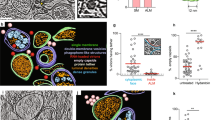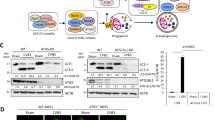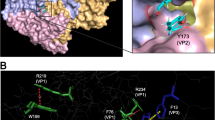Abstract
RNA viruses can rapidly mutate and acquire resistance to drugs that directly target viral enzymes, which poses serious problems in a clinical context. Therefore, there is a growing interest in the development of antiviral drugs that target host factors critical for viral replication, since they are unlikely to mutate in response to therapy. We recently demonstrated that phosphatidylinositol-4-kinase IIIβ (PI4KIIIβ) and its product phosphatidylinositol-4-phosphate (PI4P) are essential for replication of enteroviruses, a group of medically important RNA viruses including poliovirus (PV), coxsackievirus, rhinovirus, and enterovirus 71. Here, we show that enviroxime and GW5074 decreased PI4P levels at the Golgi complex by directly inhibiting PI4KIIIβ. Coxsackievirus mutants resistant to these inhibitors harbor single point mutations in the non-structural protein 3A. These 3A mutations did not confer compound-resistance by restoring the activity of PI4KIIIβ in the presence of the compounds. Instead, replication of the mutant viruses no longer depended on PI4KIIIβ, since their replication was insensitive to siRNA-mediated depletion of PI4KIIIβ. The mutant viruses also did not rely on other isoforms of PI4K. Consistently, no high level of PI4P could be detected at the replication sites induced by the mutant viruses in the presence of the compounds. Collectively, these findings indicate that through specific single point mutations in 3A, CVB3 can bypass an essential host factor and lipid for its propagation, which is a new example of RNA viruses acquiring resistance against antiviral compounds, even when they directly target host factors.
Similar content being viewed by others
Log in or create a free account to read this content
Gain free access to this article, as well as selected content from this journal and more on nature.com
or
References
Gern JE . The ABCs of rhinoviruses, wheezing, and asthma. J Virol 2010; 84:7418–7426.
Mallia P, Contoli M, Caramori G, Pandit A, Johnston SL, Papi A . Exacerbations of asthma and chronic obstructive pulmonary disease (COPD): focus on virus induced exacerbations. Curr Pharm Des 2007; 13:73–97.
Tebruegge M, Curtis N . Enterovirus infections in neonates. Semin Fetal Neonatal Med 2009; 14:222–227.
Whitton JL, Cornell CT, Feuer R . Host and virus determinants of picornavirus pathogenesis and tropism. Nat Rev Microbiol 2005; 3:765–776.
Bible JM, Pantelidis P, Chan PK, Tong CY . Genetic evolution of enterovirus 71: epidemiological and pathological implications. Rev Med Virol 2007; 17:371–379.
Bedard KM, Semler BL . Regulation of picornavirus gene expression. Microbes Infect 2004; 6:702–713.
Heinz BA, Vance LM . The antiviral compound enviroxime targets the 3A coding region of rhinovirus and poliovirus. J Virol 1995; 69:4189–4197.
Heinz BA and Vance LM . Sequence determinants of 3A-mediated resistance to enviroxime in rhinoviruses and enteroviruses. J Virol 1996; 70:4854–4857.
Wikel JH, Paget CJ, DeLong DC, et al. Synthesis of syn and anti isomers of 6-[[(hydroxyimino)phenyl]methyl]-1-[(1-methylethyl)sulfonyl]-1H-benzimidazol-2-amine. Inhibitors of rhinovirus multiplication. J Med Chem 1980; 23:368–372.
Brown-Augsburger P, Vance LM, Malcolm SK, Hsiung H, Smith DP, Heinz BA . Evidence that enviroxime targets multiple components of the rhinovirus 14 replication complex. Arch Virol 1999; 144:1569–1585.
Arita M, Wakita T, Shimizu H . Cellular kinase inhibitors that suppress enterovirus replication have a conserved target in viral protein 3A similar to that of enviroxime. J Gen Virol 2009; 90:1869–1879.
De Palma AM, Thibaut HJ, van der Linden L, et al. Mutations in the nonstructural protein 3A confer resistance to the novel enterovirus replication inhibitor TTP-8307. Antimicrob Agents Chemother 2009; 53:1850–1857.
Liu Y, Franco D, Paul AV, Wimmer E . Tyrosine 3 of poliovirus terminal peptide VPg(3B) has an essential function in RNA replication in the context of its precursor protein, 3AB. J Virol 2007; 81:5669–5684.
Towner JS, Mazanet MM, Semler BL . Rescue of defective poliovirus RNA replication by 3AB-containing precursor polyproteins. J Virol 1998; 72:7191–7200.
Bonifacino JS, Glick BS . The mechanisms of vesicle budding and fusion. Cell 2004; 116:153–166.
Lee MC, Miller EA, Goldberg J, Orci L, Schekman R . Bi-directional protein transport between the ER and Golgi. Annu Rev Cell Dev Biol 2004; 20:87–123.
Rabouille C, Klumperman J . Opinion: The maturing role of COPI vesicles in intra-Golgi transport. Nat Rev Mol Cell Biol 2005; 6:812–817.
Cornell CT, Kiosses WB, Harkins S, Whitton JL . Inhibition of protein trafficking by coxsackievirus b3: multiple viral proteins target a single organelle. J Virol 2006; 80:6637–6647.
Doedens JR, Kirkegaard K . Inhibition of cellular protein secretion by poliovirus proteins 2B and 3A. EMBO J 1995; 14:894–907.
Hsu NY, Ilnytska O, Belov G, et al. Viral reorganization of the secretory pathway generates distinct organelles for RNA replication. Cell 2010; 141:799–811.
Wessels E, Duijsings D, Notebaart RA, Melchers WJ, van Kuppeveld FJ . A proline-rich region in the coxsackievirus 3A protein is required for the protein to inhibit endoplasmic reticulum-to-golgi transport. J Virol 2005; 79:5163–5173.
Belov GA, Feng Q, Nikovics K, Jackson CL, Ehrenfeld E . A critical role of a cellular membrane traffic protein in poliovirus RNA replication. PLoS Pathog 2008; 4:e1000216.
Wessels E, Duijsings D, Niu TK, et al. A viral protein that blocks Arf1-mediated COP-I assembly by inhibiting the guanine nucleotide exchange factor GBF1. Dev Cell 2006; 11:191–201.
D'Angelo G, Vicinanza M, Di Campli A, De Matteis MA . The multiple roles of PtdIns(4)P – not just the precursor of PtdIns(4,5)P2. J Cell Sci 2008; 121:1955–1963.
Graham TR, Burd CG . Coordination of Golgi functions by phosphatidylinositol 4-kinases. Trends Cell Biol 2011; 21:113–121.
Santiago-Tirado FH, Bretscher A . Membrane-trafficking sorting hubs: cooperation between PI4P and small GTPases at the trans-Golgi network. Trends Cell Biol 2011; 21:515–525.
Blumental-Perry A, Haney CJ, Weixel KM, Watkins SC, Weisz OA, Aridor M . Phosphatidylinositol 4-phosphate formation at ER exit sites regulates ER export. Dev Cell 2006; 11:671–682.
Lorente-Rodriguez A, Barlowe C . Requirement for Golgi-localized PI(4)P in fusion of COPII vesicles with Golgi compartments. Mol Biol Cell 2011; 22:216–229.
Arita M, Wakita T, Shimizu H . Characterization of pharmacologically active compounds that inhibit poliovirus and enterovirus 71 infectivity. J Gen Virol 2008; 89:2518–2530.
Balla A, Tuymetova G, Toth B, et al. Design of drug-resistant alleles of type-III phosphatidylinositol 4-kinases using mutagenesis and molecular modeling. Biochemistry 2008; 47:1599–1607.
Knight ZA, Gonzalez B, Feldman ME, et al. A pharmacological map of the PI3-K family defines a role for p110alpha in insulin signaling. Cell 2006; 125:733–747.
Arita M, Kojima H, Nagano T, Okabe T, Wakita T, Shimizu H . Phosphatidylinositol 4-kinase III beta is a target of enviroxime-like compounds for antipoliovirus activity. J Virol 2011; 85:2364–2372.
Balla A, Tuymetova G, Tsiomenko A, Varnai P, Balla T . A plasma membrane pool of phosphatidylinositol 4-phosphate is generated by phosphatidylinositol 4-kinase type-III alpha: studies with the PH domains of the oxysterol binding protein and FAPP1. Mol Biol Cell 2005; 16:1282–1295.
Godi A, Di Campli A, Konstantakopoulos A, et al. FAPPs control Golgi-to-cell-surface membrane traffic by binding to ARF and PtdIns(4)P. Nat Cell Biol 2004; 6:393–404.
He J, Scott JL, Heroux A, et al. Molecular basis of phosphatidylinositol 4-phosphate and ARF1 GTPase recognition by the FAPP1 pleckstrin homology (PH) domain. J Biol Chem 2011; 286:18650–18657.
Toth B, Balla A, Ma H, Knight ZA, Shokat KM, Balla T . Phosphatidylinositol 4-kinase IIIbeta regulates the transport of ceramide between the endoplasmic reticulum and Golgi. J Biol Chem 2006; 281:36369–36377.
Godi A, Pertile P, Meyers R, et al. ARF mediates recruitment of PtdIns-4-OH kinase-beta and stimulates synthesis of PtdIns(4,5)P2 on the Golgi complex. Nat Cell Biol 1999; 1:280–287.
Kahn RA, Volpicelli-Daley L, Bowzard B, et al. Arf family GTPases: roles in membrane traffic and microtubule dynamics. Biochem Soc Trans 2005; 33:1269–1272.
Hausser A, Storz P, Martens S, Link G, Toker A, Pfizenmaier K . Protein kinase D regulates vesicular transport by phosphorylating and activating phosphatidylinositol-4 kinase IIIbeta at the Golgi complex. Nat Cell Biol 2005; 7:880–886.
Bain J, Plater L, Elliott M, et al. The selectivity of protein kinase inhibitors: a further update. Biochem J 2007; 408:297–315.
Lackey K, Cory M, Davis R, et al. The discovery of potent cRaf1 kinase inhibitors. Bioorg Med Chem Lett 2000; 10:223–226.
Prudent R, Moucadel V, Lopez-Ramos M, et al. Expanding the chemical diversity of CK2 inhibitors. Mol Cell Biochem 2008; 316:71–85.
Horiuchi KY, Wang Y, Diamond SL, Ma H . Microarrays for the functional analysis of the chemical-kinase interactome. J Biomol Screen 2006; 11:48–56.
Li M, Smith CJ, Walker MT, Smith TJ . Novel inhibitors complexed with glutamate dehydrogenase: allosteric regulation by control of protein dynamics. J Biol Chem 2009; 284:22988–23000.
Levine TP and Munro S . Targeting of Golgi-specific pleckstrin homology domains involves both PtdIns 4-kinase-dependent and -independent components. Curr Biol 2002; 12:695–704.
Berger KL, Cooper JD, Heaton NS, et al. Roles for endocytic trafficking and phosphatidylinositol 4-kinase III alpha in hepatitis C virus replication. Proc Natl Acad Sci USA 2009; 106:7577–7582.
Berger KL, Kelly SM, Jordan TX, Tartell MA, Randall G . Hepatitis C virus stimulates the phosphatidylinositol 4-kinase III alpha-dependent phosphatidylinositol 4-phosphate production that is essential for its replication. J Virol 2011; 85:8870–8883.
Borawski J, Troke P, Puyang X, et al. Class III phosphatidylinositol 4-kinase alpha and beta are novel host factor regulators of hepatitis C virus replication. J Virol 2009; 83:10058–10074.
Lim YS, Hwang SB . Hepatitis C virus NS5A protein interacts with phosphatidylinositol 4-kinase type IIIalpha and regulates viral propagation. J Biol Chem 2011; 286:11290–11298.
Reiss S, Rebhan I, Backes P, et al. Recruitment and activation of a lipid kinase by hepatitis C virus NS5A is essential for integrity of the membranous replication compartment. Cell Host Microbe 2011; 9:32–45.
Tai AW, Benita Y, Peng LF, et al. A functional genomic screen identifies cellular cofactors of hepatitis C virus replication. Cell Host Microbe 2009; 5:298–307.
Tai AW, Salloum S . The role of the phosphatidylinositol 4-kinase PI4KA in hepatitis C virus-induced host membrane rearrangement. PLoS One 2011; 6:e26300.
Trotard M, Lepere-Douard C, Regeard M, et al. Kinases required in hepatitis C virus entry and replication highlighted by small interference RNA screening. FASEB J 2009; 23:3780–3789.
Mackenzie JM, Khromykh AA, Parton RG . Cholesterol manipulation by West Nile virus perturbs the cellular immune response. Cell Host Microbe 2007; 2:229–239.
Martin-Acebes MA, Blazquez AB, Jimenez de ON, Escribano-Romero E, Saiz JC . West Nile virus replication requires fatty acid synthesis but is independent on phosphatidylinositol-4-phosphate lipids. PLoS One 2011; 6:e24970.
Heaton NS, Perera R, Berger KL, et al. Dengue virus nonstructural protein 3 redistributes fatty acid synthase to sites of viral replication and increases cellular fatty acid synthesis. Proc Natl Acad Sci USA 2010; 107:17345–17350.
Perera R, Riley C, Isaac G, et al. Dengue virus infection perturbs lipid homeostasis in infected mosquito cells. PLoS Pathog 2012; 8:e1002584.
Heaton NS, Randall G . Multifaceted roles for lipids in viral infection. Trends Microbiol 2011; 19:368–375.
Crotty S, Saleh MC, Gitlin L, Beske O, Andino R . The poliovirus replication machinery can escape inhibition by an antiviral drug that targets a host cell protein. J Virol 2004; 78:3378–3386.
Belov GA, Kovtunovych G, Jackson CL, Ehrenfeld E . Poliovirus replication requires the N-terminus but not the catalytic Sec7 domain of ArfGEF GBF1. Cell Microbiol 2010; 12:1463–1479.
Coelmont L, Hanoulle X, Chatterji U, et al. DEB025 (Alisporivir) inhibits hepatitis C virus replication by preventing a cyclophilin A induced cis-trans isomerisation in domain II of NS5A. PLoS One 2010; 5:e13687.
Lanke KH, van der Schaar HM, Belov GA, et al. GBF1, a guanine nucleotide exchange factor for Arf, is crucial for coxsackievirus B3 RNA replication. J Virol 2009; 83:11940–11949.
Reed LJ, Muench H . A simple method of estimating fifty percent endpoints. Am J Hyg 1938; 27:493–497.
Zhao XH, Bondeva T, Balla T . Characterization of recombinant phosphatidylinositol 4-kinase beta reveals auto- and heterophosphorylation of the enzyme. J Biol Chem 2000; 275:14642–14648.
Jung G, Barylko B, Lu D, Shu H, Yin H, Albanesi JP . Stabilization of phosphatidylinositol 4-kinase type IIbeta by interaction with Hsp90. J Biol Chem 2011; 286:12775–12784.
van Kuppeveld FJ, Galama JM, Zoll J, Melchers WJ . Genetic analysis of a hydrophobic domain of coxsackie B3 virus protein 2B: a moderate degree of hydrophobicity is required for a cis-acting function in viral RNA synthesis. J Virol 1995; 69:7782–7790.
Acknowledgements
We are grateful to Drs K Conrath and M Andrews (Galapagos NV, Belgium) for performing the in vitro PI4K activity assay. We also thank Drs N Altan-Bonnet (Rutgers University, USA) and T Balla (National Institute for Health, USA) for fruitful discussions and for providing plasmids, Dr F Wieland (Biochemie-Zentrum, Germany) for providing antibodies and Dr J Albanesi (UT Southwestern Medical Center, Texas) for providing plasmids. This work was supported by research grants from the “Covenant K.U. Leuven-Radboud University Nijmegen” framework, the Netherlands Organization for Scientific Research (NWO-ECHO-700.57.001 and NWO-ALW-820.02.018), and the SILVER Large Scale Collaborative Project (grant agreement number 260644) of the European Union 7th Framework. The funders had no role in study design, data collection and analysis, decision to publish, or preparation of the manuscript.
Author information
Authors and Affiliations
Corresponding author
Additional information
( Supplementary information is linked to the online version of the paper on the Cell Research website.)
Supplementary information
Supplementary information, Figure S1
Golgi-localization of FAPP1-PH-GFP is predominantly determined by PI4KIIIβ. (PDF 57 kb)
Supplementary information, Figure S2
Enviroxime, GW5074, and PIK93 do not affect PI4KIIIβ recruitment by wild-type 3A or 3A-H57Y. (PDF 118 kb)
Supplementary information, Figure S3
SiRNA-treatment does not induce cytotoxic effects on cells. (PDF 44 kb)
Supplementary information, Figure S4
Efficient depletion of PI4KIIβ by siRNA-treatment. (PDF 43 kb)
Rights and permissions
About this article
Cite this article
van der Schaar, H., van der Linden, L., Lanke, K. et al. Coxsackievirus mutants that can bypass host factor PI4KIIIβ and the need for high levels of PI4P lipids for replication. Cell Res 22, 1576–1592 (2012). https://doi.org/10.1038/cr.2012.129
Received:
Revised:
Accepted:
Published:
Issue date:
DOI: https://doi.org/10.1038/cr.2012.129
Keywords
This article is cited by
-
Human-type sialic acid receptors contribute to avian influenza A virus binding and entry by hetero-multivalent interactions
Nature Communications (2022)
-
Novel capsid binder and PI4KIIIbeta inhibitors for EV-A71 replication inhibition
Scientific Reports (2021)
-
The Golgi protein ACBD3 facilitates Enterovirus 71 replication by interacting with 3A
Scientific Reports (2017)
-
A new paradigm in viral resistance
Cell Research (2012)



